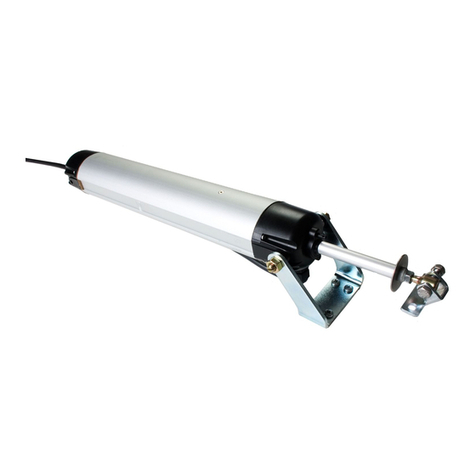Doc. 82082-Z Rev. 04/07/07 3 / 8 Dis. 17088/l
AVVERTENZE PER LA SICUREZZA
"! Gli attuatori devono essere installati da personale qualificato.
"! Prima di procedere all’installazione verificare che:
-le prestazioni dell’attuatore siano adeguate all’applicazione prevista
-i profili e gli accessori del portellone siano adeguatamente dimensionati per le sollecitazioni prodotte dell’attuatore
-gli impianti elettrici esistenti siano conformi alle norme vigenti
- l’alimentazione elettrica abbia le caratteristiche indicate nei dati tecnici dell’attuatore
"! Verificare che il cavo di alimentazione non sia sollecitato durante il funzionamento.
"! Durante le operazioni di montaggio e smontaggio dell’attuatore adottare opportuni accorgimenti per prevenire chiusure accidentali
del portellone che possono determinare lesioni alle persone (urto - schiacciamento - taglio - cesoiamento).
"! Controllare visivamente almeno una volta all’anno che il cavo di alimentazione non sia danneggiato e non siano presenti altri segni
di usura.
"! Non effettuare interventi sull’attuatore, non aprire o smontare parti dell’attuatore; in caso di anomalie o cavo danneggiato rivolgersi
a “UCS – Ultraflex Control Systems srl”.
COLLEGAMENTI ELETTRICI (figg. 4-5)
"! Effettuare i collegamenti elettrici secondo gli schemi di fig. 4 o di fig. 5.
Attenzione: Verificare la correttezza dei collegamenti elettrici.
"! Collegare l’alimentazione elettrica e verificarne il corretto funzionamento.
SOLUZIONE DEI PROBLEMI
Problema: L’attuatore si richiude lentamente dopo avere aperto il portellone.
Solutione: Il peso del portellone è eccessivo per l’attuatore nella posizione in cui è montato. Spostare l’attuatore rispetto alle
cerniere del portellone in modo da sfruttare al massimo la forza (vedere Tab. B).
Problema: L’attuatore non apre.
Solutione: Il cablaggio elettrico è errato?
L’alimentazione è insufficiente?
Il fusibile è saltato?
Il peso del portellone è eccessivo per l’attuatore nella posizione in cui è montato. Spostare l’attuatore rispetto alle
cerniere del portellone in modo da sfruttare al massimo la forza (vedere Tab. B).
NOTA: l’acqua ferma sul portellone può aggiungere un carico non indifferente al peso proprio del portellone e impedire
una apertura che in una altra occasione, senza il carico acqua, era avvenuta regolarmente.
CONDIZIONI DI GARANZIA
La Società Ultraflex Control Systems S.r.l. garantisce che i suoi prodotti sono costruiti a regola d'arte e che sono privi di difetti di
fabbricazione e di materiali.
Questa garanzia è valida per un periodo di due anni, decorrenti dalla data di fabbricazione dei prodotti ed è limitata alla sostituzione o
riparazione gratuita del pezzo che, entro il termine suddetto, ci sarà restituito in porto franco e che rileveremo essere effettivamente
difettoso nei materiali o/e nella fabbricazione.
E' escluso dalla garanzia ogni e qualsiasi altro danno diretto o indiretto.
In particolare è escluso dalla garanzia e da qualsiasi nostra responsabilità (tranne quella di sostituire o riparare, nei termini e alle
condizioni suddette, i pezzi difettosi) il malfunzionamento dei nostri prodotti qualora il loro mancato o difettoso funzionamento sia
attribuibile ad un'errata installazione o ad un uso negligente o improprio.
CORRETTO SMALTIMENTO DEL PRODOTTO
Il corretto smaltimento delle apparecchiature obsolete contribuisce a prevenire possibili conseguenze negative sull'ambiente.
"! Please read very carefully these instructions before installation.
"! Improper use or incorrect installation may cause faulty operation, which could result in subsequent damage to property and/or
injury to persons.
"! For “not supply object” we recommend anyway to follow advised technical particulars.
"! The Manufacturer, UCS – Ultraflex Control Systems srl, does not accept responsabilities for wrong applications and/or installations
where installation instruction have’t been followed or non-original spare parts have been used.
PRODUCT DESCRIPTION AND RECOMMENDED UTILIZATION
"! AV electromechanical hatch lifting systems have been especially designed for marine pleasure boats and allow opening and closing
of engine compartments, hatchways, etc.
"! ANTI-DEFLAGRANCE: the AV hatch lifting AV 3012, AV 4512 and AV 6012 are designed to be installed in a room where the
anti-deflagrance certification is required (in accordance with requirements of the Standard for Ignition-Protection Test for
Marine Products, UL 1500, and the Standard for Protection Against Ignition of Surrounding Flammable Gases, UNI EN ISO
28846 / ISO 8846).
"! AV electromechanical hatch lifting systems are water resistant, but are not intended to be submerged.
"! AV electromechanical hatch lifting system has been projected for single and dual application.
"! The AV models with a non-locking actuating ram
- pushes with a force of 1200 N (265 pounds); 2400 N (530 pounds) for dual application.
- allows the hatch to be manually open in case of power failure.
Warning: do not use the AV (non-locking) actuators on high performance boats or any other application where the hatch could be
blown open while underway. Doing so could cause serious damage to the boat and /or injury to persons.
"! The AVL models with a locking actuating ram
- pushes with a force of 1200 N (265 pounds); 2400 N (530 pounds) for dual application
- pull with a force of 650 N (143 pounds); 1300 N (286 pounds) for dual application
The following instructions contain important safety information and must be forwarded to the
owner of the boat
GB


























